Gutter gardens are typically evanescent items; adventurous weeds today, washed away tomorrow. Nevertheless I am a fan. They have a hectic enthusiasm, little scatters of the wild growing up out of our urban environment practicalities.
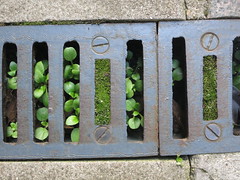
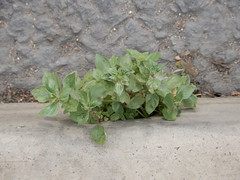
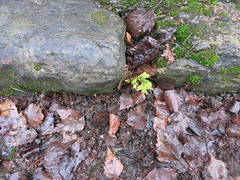
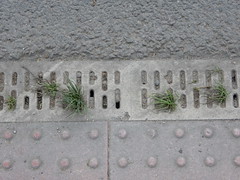
But would it be possible to design in these awkward little threads of green?
This is a concealed drain in my local mall which is open-style; rain and weather blows in, and needs to be shifted from the hardstanding. A slight slope in the paved area draws water down into the central runnel (the dark streak dead centre) from where it is whisked off into the local drainage system and away. So far, so bare. Now let's look at how the drainage runnel is doing just outside the roofed area, near a decorative garden:
You'll notice a built-up, almost what one might call a substrate, blocking the runnel, made of particulates, dust, plant debris, leftover building materials (a list to make our hardy urban plantset rootdrool) and the first moment it rains I rather think that this might happen:
Of course, this is the rough and ready sort of greenvasion. The first proper hard rain will wash those tiny seedlings away. But with a little planning, could we make our green gutters more structured, more considered, more permanent?
Here very roughly is how our concealed drain is working. Slowing down that wash-away might bring other benefits, too - cooling the area, reducing run-off. Let's work on that.
Here a grill has been added, containing hard-wearing plants. Hydroponic plus, they grow in debris with roots dipped in water. The little green grid creates a pedestrian speedbump that slows traffic and creates a natural milling-spot just outside the social (a convivial cafe-space). The gap halfway up is a throughbridge for wheeled traffic like wheelchair users, pushchairs and service vehicles, but it's expected and understood that this will be trodden on. Plants will live and die in this space. Lots will never make it past seedling, and anything too big will need to be weeded out in any case.
My original conception, above, retains more of an air of mystery, of green bubbling up through the cracks in a pavement (more on pavements is coming soon!). This one would suffer less from evaporation, but would be harder to maintain -- it might require easily liftable blocks. I think it might be worth it though, especially in areas like walkways and balconies.
The raw material greenery photo for my final design is worth a look, as it is the original design inspiration, and always in my mind when I'm thinking green gutters. This drain has long since fallen to the winds and waves of urban improvement, but in its day it was downstream from a coffee van, and a regular recipient of water, ice etc. dropped off the van at the end of the day, and occasional flushes of coffee grounds when something went wrong. The plants grew in it with tiny abandon, delighted with their little garden spaces:
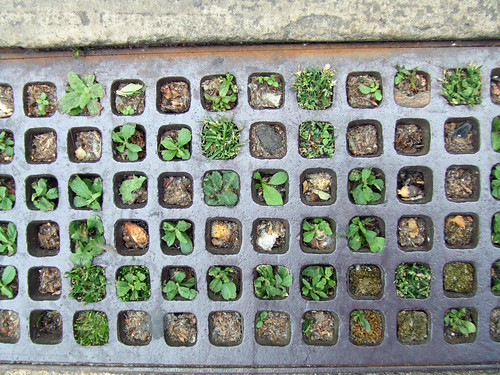
So, they obviously exist already, but are equally obviously evanescent, rather than year-round planting. They're also only ever accidental, never intentional.
Towards intentionality
Building in spaces for the weeds may be the easiest way to green cities. There's no expensive planting to coddle and manage; watering takes care of itself (or doesn't, during droughts); and bad weeding out the saplings, maintenance is low.
But to the urbanite's eye this communicates messy, tatty, urban decay. To the building services manager, it is roots to clog and prise and tweeze and penetrate. To the street cleaning crew, it's a job for the pressure washer and the hoe.
If these are to stay they are going to need to communicate intentionality, effectively.
Practicalities
So what do we need, to get from here to there?




But would it be possible to design in these awkward little threads of green?
This is a concealed drain in my local mall which is open-style; rain and weather blows in, and needs to be shifted from the hardstanding. A slight slope in the paved area draws water down into the central runnel (the dark streak dead centre) from where it is whisked off into the local drainage system and away. So far, so bare. Now let's look at how the drainage runnel is doing just outside the roofed area, near a decorative garden:
You'll notice a built-up, almost what one might call a substrate, blocking the runnel, made of particulates, dust, plant debris, leftover building materials (a list to make our hardy urban plantset rootdrool) and the first moment it rains I rather think that this might happen:
Of course, this is the rough and ready sort of greenvasion. The first proper hard rain will wash those tiny seedlings away. But with a little planning, could we make our green gutters more structured, more considered, more permanent?
Here very roughly is how our concealed drain is working. Slowing down that wash-away might bring other benefits, too - cooling the area, reducing run-off. Let's work on that.
Here a grill has been added, containing hard-wearing plants. Hydroponic plus, they grow in debris with roots dipped in water. The little green grid creates a pedestrian speedbump that slows traffic and creates a natural milling-spot just outside the social (a convivial cafe-space). The gap halfway up is a throughbridge for wheeled traffic like wheelchair users, pushchairs and service vehicles, but it's expected and understood that this will be trodden on. Plants will live and die in this space. Lots will never make it past seedling, and anything too big will need to be weeded out in any case.
My original conception, above, retains more of an air of mystery, of green bubbling up through the cracks in a pavement (more on pavements is coming soon!). This one would suffer less from evaporation, but would be harder to maintain -- it might require easily liftable blocks. I think it might be worth it though, especially in areas like walkways and balconies.
The raw material greenery photo for my final design is worth a look, as it is the original design inspiration, and always in my mind when I'm thinking green gutters. This drain has long since fallen to the winds and waves of urban improvement, but in its day it was downstream from a coffee van, and a regular recipient of water, ice etc. dropped off the van at the end of the day, and occasional flushes of coffee grounds when something went wrong. The plants grew in it with tiny abandon, delighted with their little garden spaces:

So, they obviously exist already, but are equally obviously evanescent, rather than year-round planting. They're also only ever accidental, never intentional.
Towards intentionality
Building in spaces for the weeds may be the easiest way to green cities. There's no expensive planting to coddle and manage; watering takes care of itself (or doesn't, during droughts); and bad weeding out the saplings, maintenance is low.
But to the urbanite's eye this communicates messy, tatty, urban decay. To the building services manager, it is roots to clog and prise and tweeze and penetrate. To the street cleaning crew, it's a job for the pressure washer and the hoe.
If these are to stay they are going to need to communicate intentionality, effectively.
Practicalities
So what do we need, to get from here to there?
- Pre-moulded building parts made of durable materials with space for gunk and green to gather, but enough drainage not to cause puddles
- A list of safe and unsafe plants, according to which have roots inclined to penetrate and damage, and which can be safely relied up on to matt (green roofs should have this, and more on them later)
- A shift in attitude to see the volunteer greenery within an area as part of the building assets rather than a litter problem to be cleared (perhaps lead by identification posters, or ones that give statistics about drainage and cooling)
- A better knowledge of our urban plant habitat, and an understanding of the species web we can support withing the urban environment (perhaps a book called Flowers of the Urban and Built Environment)
- Someone to build this idea into a striking new town centre scheme.






No comments:
Post a Comment